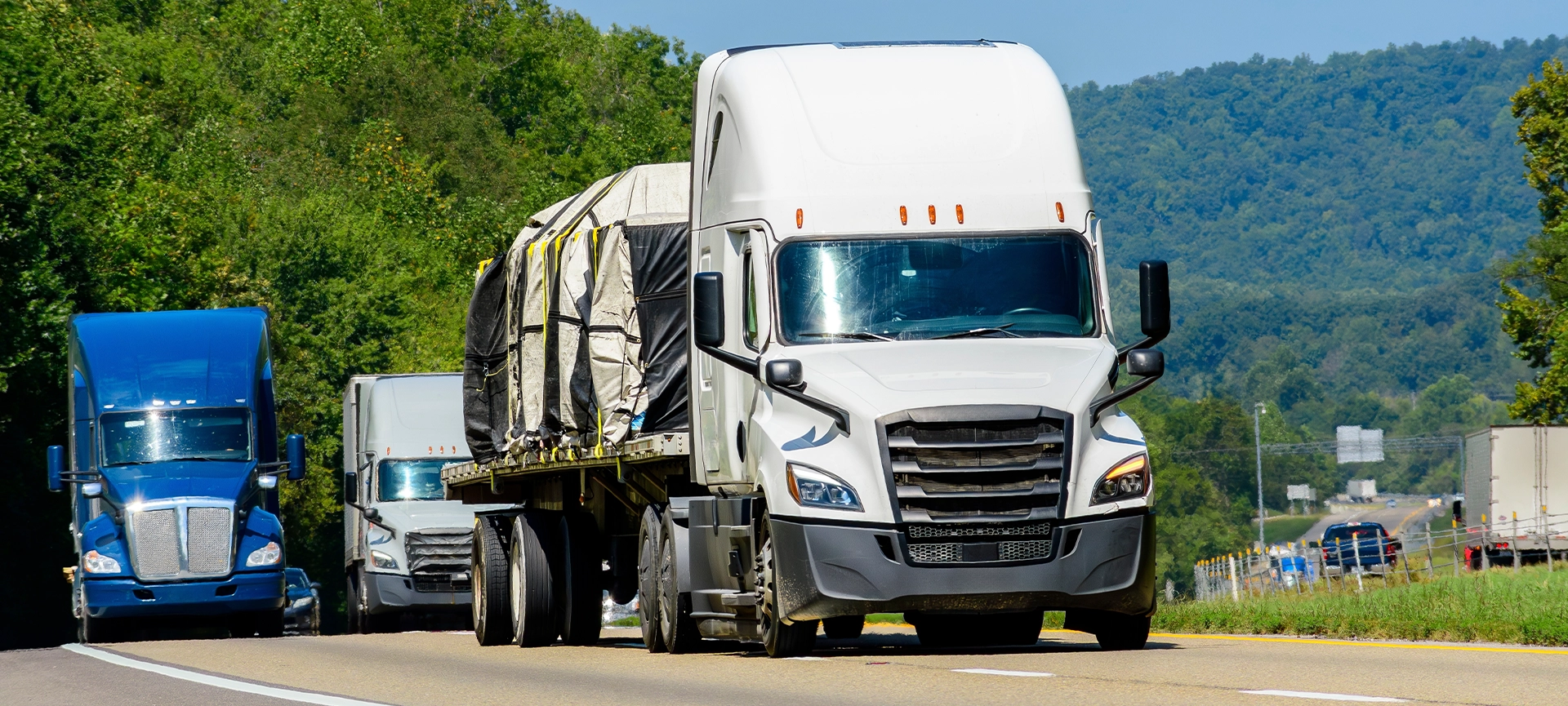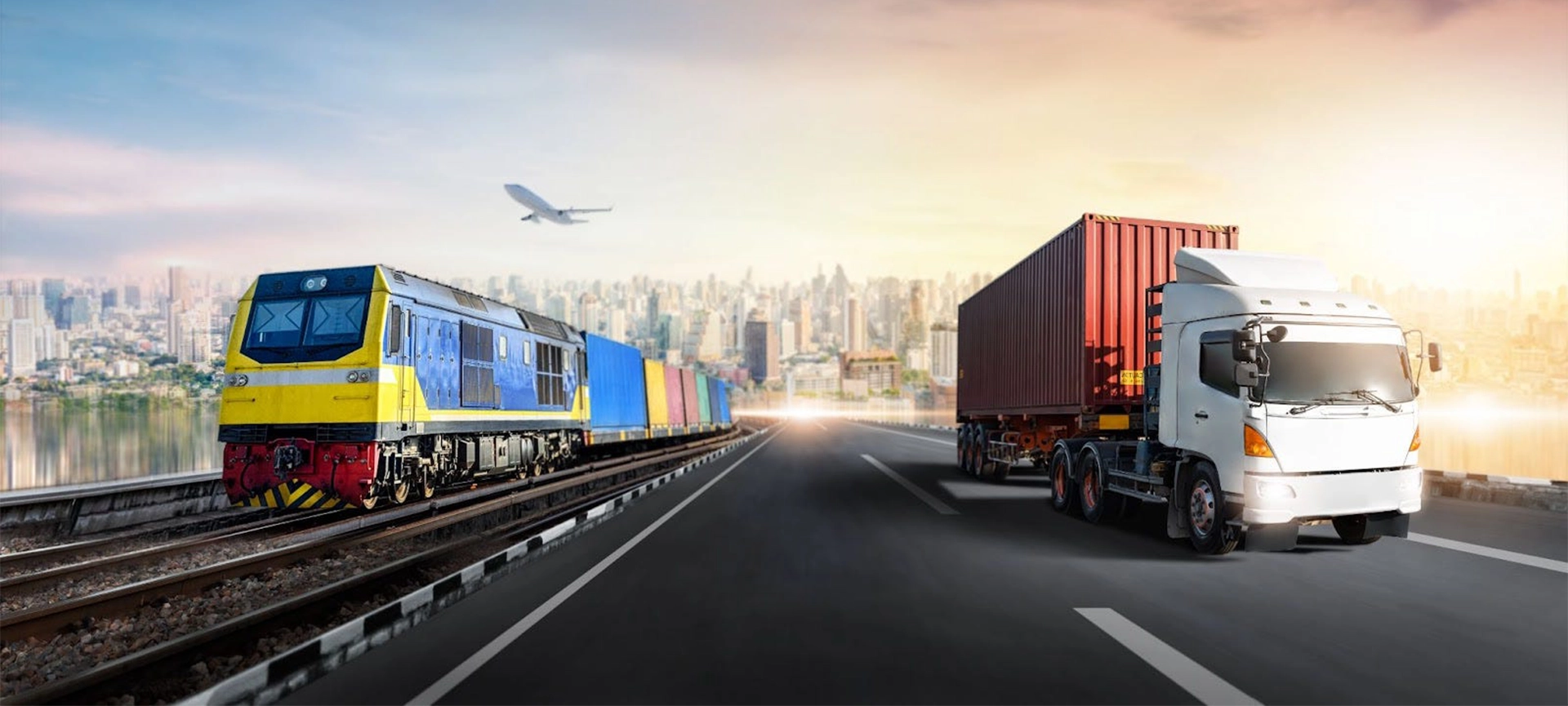Flatbed vs. Dry Van: Which One Is Right for Your Business?
The white glove delivery is a big differentiator in logistics, but when it comes to moving bulk freight or high-volume goods, choosing the right trailer is just as important. For companies that ship regularly or truck drivers planning their routes, understanding the main differences between flatbed and dry van trailers is key.
Your trailer choice affects the types of cargo you can haul, how it can be loaded and unloaded and the final delivery cost. Dry vans are enclosed and perfect for boxed, palletized goods; flatbeds are versatile for large, heavy or irregular loads.
In this guide, we’ll compare flatbed and dry van trailers in depth (trailer types, cargo compatibility, load dimensions, pros and cons, industry use cases and driver considerations) so you can make the right choice for your business or fleet.
Related Article: Explore the Cost Factors of Dry Van Shipping: Strategies for Cost-Effective Transportation Solution
What Is a Dry Van?
A dry van is one of the most popular trailers in North American freight transportation. It’s a fully enclosed, non-climate-controlled trailer that protects goods from rain, debris, theft, and other external elements. If you’re wondering what a dry van truck is, it’s the trailer attached to a semi-truck that hauls cargo that needs to stay dry and secure.
Because of their versatility, dry vans are the default for most standard shipments. They’re used in both LTL freight (less-than-truckload) and full truckload operations. With doors in the rear and a flat box-like interior, they’re perfect for dock loading with forklifts or pallet jacks.
Common Goods Transported in Dry Vans:
- Electronics and computer hardware
- Furniture and home goods
- Packaged food and beverages
- Clothing, textiles and footwear
- Books, paper and print materials
- Cleaning supplies and chemicals
- Pharmaceuticals and over-the-counter drugs
Dry vans are great for companies shipping non-perishable items in high volume. When used with a dry van freight provider, businesses can get consistent schedules, better protection and scalability.
Types of Dry Vans
Dry vans may look the same on the outside, but are built differently and used for different purposes. Whether you need to haul heavy pallets, fragile goods or require specific interior features, choosing the right type of dry van affects both cost and cargo safety.
Three main types of dry vans:
Sheet and Post Dry Vans
- Built with vertical steel or aluminum posts and aluminum sheeting
- Light and affordable
- Easier and cheaper to repair
- Slightly less interior width due to the spacing of vertical posts
- Good for general cargo that doesn’t require maximum internal volume
These are common in LTL freight and regional deliveries where versatility and affordability are key.
Plate Dry Vans
- Built with corrugated metal panels (often steel or composite materials)
- Smoother, more consistent walls increase usable interior space
- More durable and resistant to side impacts and wear
- Preferred by big volume shippers and companies moving high-density cargo
- Used for long-haul and full truckload shipments
If you’re comparing a plate trailer vs dry van built with sheet and post, plate trailers are usually the better option for maximum capacity and durability, but they cost more.
Custom Spec Dry Vans
- Built for specific cargo or performance needs
- May have vented dry van walls for airflow or reinforced floors for heavy machinery
- Chosen by companies shipping temperature-sensitive products or products that require added security
- Can have options for heated transportation or integration with portable cooling units
Custom trailers are used for niche operations, shipping food from Canada to the US, or pharmaceuticals, where strict handling standards are required.
Related Article: Dry Van Rates 2025
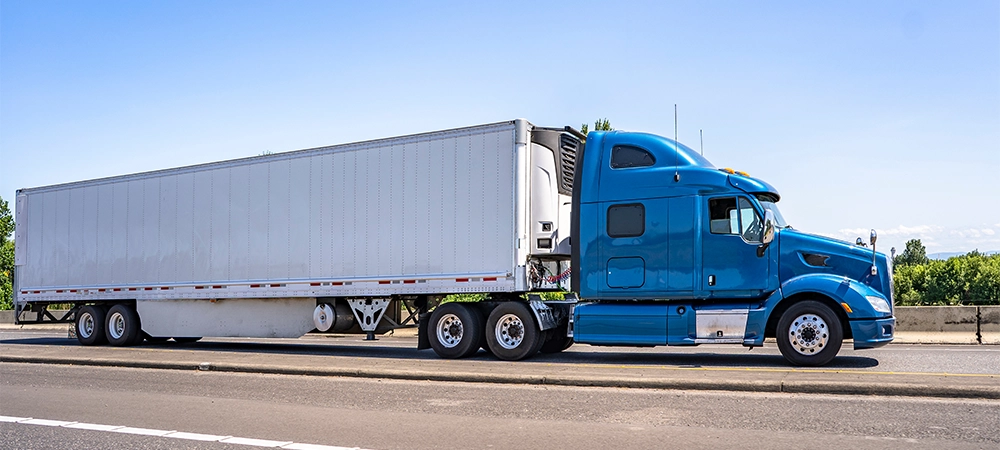
What Is a Flatbed?
A flatbed trailer is an open-deck trailer with no sides or roof, designed to carry oversized or irregularly shaped freight. It’s built for flexibility and ease of access, so cargo can be loaded from the top, sides or rear using forklifts, cranes or even manual labour.
When people ask what a flatbed truck is, they’re usually referring to the trailer part of a semi-truck used to haul freight that won’t fit in a standard enclosed trailer. Flatbeds are super valuable in industries like construction, manufacturing, agriculture and energy where materials are heavy, long, wide or tall.
Because of their open design, flatbeds aren’t used for weather-sensitive goods unless tarped. But their versatility makes them the go-to choice for freight that can’t be boxed or palletized.
Typical Loads Carried by Flatbed Trailers:
- Steel coils, bars and rebar
- Lumber and building supplies
- Heavy machinery and construction equipment
- Concrete pipes and precast components
- Vehicles, tractors and industrial tanks
- Large HVAC units and utility poles
Flatbed shipping is also used for cross-border moves and is supported by services like flatbed freight at Roadlinx. If you need to move cargo that’s too big or heavy for a dry van, a flatbed is your best bet.
Types of Flatbed Trailers
Flatbeds come in many configurations to handle different types of freight. From basic pallets to massive wind turbine blades, each type of flatbed has a specific job in modern logistics. Knowing your options means compliance, efficiency and cost savings.
Standard Flatbed
- The most popular flatbed trailer
- 48 to 53 feet long
- Palletized freight, lumber, pipe, and wrapped equipment
- Load/unload from any side with forklifts or cranes
- Height limit: 8 feet 6 inches (before special permits required)
- Standard flatbed dimensions are 48’ x 8.5’ x 5’ deck height
Standard flatbeds are the workhorse of open-deck hauling and are used for everyday construction, industrial and agricultural freight.
Step Deck (Drop Deck) Flatbed
- Two deck levels: upper and lower
- Lower deck for taller cargo up to 10 feet without permits
- For equipment like forklifts, tractors and compact excavators
- Easier to meet height restrictions on highways
- Used when flatbed dims aren’t enough to meet vertical clearance needs
Step decks are the smart choice when shipping tall but not heavy items.
Double Drop Flatbed
- Also known as a lowboy or well-deck trailer
- A “well” in the middle of the trailer for extra-tall freight
- Heavy machinery transport or turbine component shipping
- One of the lowest deck heights (under 3 feet)
- For specialized freight that exceeds standard height and weight limits
If you’re wondering how tall a flatbed load is, a double drop is the highest without special permits.
Specialty Flatbeds
There are other trailer types for unique or extreme loads:
- Stretch Flatbeds: For long beams, tubing or wind blades
- Removable Gooseneck (RGN): Detaches at the front so vehicles can drive onto the trailer
- Flatbed Trailer with Liftgate: To deliver cargo to ground level where no dock exists
- Lowboy Trailers: Sit extremely close to the ground for heavy over-height equipment\
- Conestoga Trailers: Flatbeds with tarp systems to load/unload freight
Used in flatbed shipping for oil and gas, defence, and renewable energy.
Related Article: Why You Need Flatbed Trailer Rental
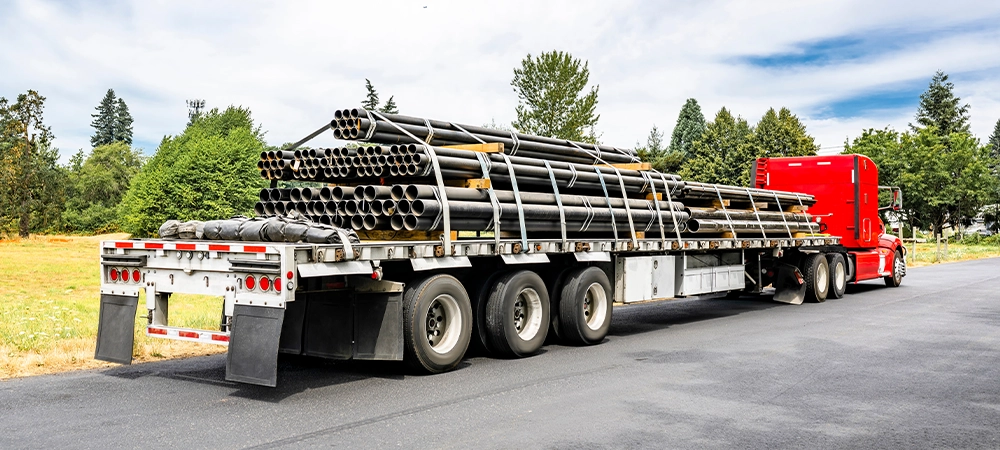
Dimensions and Specifications
Before you choose a trailer, you need to understand how dry vans and flatbeds compare in size, structure and weight capacity. They may be the same length, but they are very different in design and cargo space.
Here are the standard dimensions and weight limits for dry van and flatbed trailers.
Dry Van Dimensions and Weight Limits
Dry vans are for interior protection and stackable storage. They’re for cubic space, not weight.
| Spec | Typical Measurement |
| Length | 48 ft or 53 ft |
| Width | 8 ft 6 in (exterior) |
| Interior Height | 110–114 inches |
| Weight Limit | ~45,000 lbs |
| Interior Volume | ~3,500–4,000 cu ft |
| Ground Clearance | ~48 inches |
How tall is a 53 ft dry van? From the ground to the roof, it’s usually about 13 ft 6 in — the legal height limit in most North American jurisdictions.
Vans may also have vented dry vans to allow for airflow when moving products that can’t be sealed airtight.
Flatbed Dimensions and Weight Limits
Flatbeds are for flexibility, not interior space. They’re built to handle big and heavy cargo.
| Spec | Typical Measurement |
| Length | 48 ft or 53 ft |
| Width | 8 ft 6 in |
| Deck Height | 5 ft (standard) |
| Weight Limit | ~48,000–50,000 lbs |
| Max Load Height (without permit) | 8 ft 6 in |
| Max Width (without permit) | 8 ft 6 in |
With a standard axle configuration, most flatbeds can legally carry about 48,000 pounds. But that can increase with specialized trailers or multi-axle setups.
If you’re ever in doubt, check our flatbed dimensions guide or get a flatbed shipping quote from Roadlinx to make sure your freight meets all requirements.
Related Article: Choosing the Right Flatbed Trailer for Your Shipping Requirements: A Comprehensive Guide
Pros and Cons of Each
Every trailer type has trade-offs. Dry vans offer protection and simplicity, flatbeds win on flexibility and capacity. Your choice should match the type of freight you haul, your environment, and what your customers expect from your service.
Here’s a balanced breakdown of the pros and cons of each:
Dry Van Pros
- Weather Protection: Goods stay dry and sheltered from rain, snow and debris.
- Cargo Security: Enclosed walls and lockable doors prevent theft or tampering.
- Easy to Use: Standard sizes make dry vans easy to load and compatible with most dock setups.
- Widely Available: Most freight carriers and brokers have dry van capacity, so it’s easy to find trucks.
- Less Physical Labour: No tarping or chaining required — easier on drivers.
- Best for Consumer Goods: Works well for boxed, palletized and stackable freight.
Dry Van Cons
- Limited Space: Internal height and width restrictions mean limited options for large or odd-shaped freight.
- No Side Access: Can only be loaded/unloaded from the back — not ideal for sites without docks.
- Cargo Shift Risk: Items not properly palletized or secured may shift during transit.
- Not for Oversized Loads: Items that exceed legal height or width can’t be hauled without special equipment.
- No Ventilation: Without a vented dry van, some products may be damaged by heat or humidity.
Flatbed Pros
- Cargo Flexibility: Can haul long, wide, tall and irregularly shaped items that won’t fit in a van.
- Side & Top Loading: Load freight from any direction with cranes, forklifts or overhead lifts.
- Higher Earning Potential: Flatbed rates per mile are higher due to load complexity and demand.
- Industry Specific Demand: High value industries like construction, energy and manufacturing rely on flatbeds.
- Fewer Docking Restrictions: No need for dock level access — more delivery flexibility.
Flatbed Cons
- Weather Exposure: Freight must be tarped to protect from rain, snow and sun.
- Physical Labour: Requires physical labour for load securement, often in bad weather.
- More Inspections: Visible loads mean more DOT and safety officer checks.
- Load Securement Complexity: Mistakes in chaining or strapping can damage freight or create safety risks.
- Permits: Oversized loads require planning and special permits.
Flatbed vs Dry Van: Which is Better for You?
There’s no one-size-fits-all answer to this question; it’s all about what you’re hauling, how often and where. Below, we break down the differences in cost, cargo flexibility, security and loading logistics to help you decide which trailer is best for you.
Rate Difference
One of the biggest factors when choosing a trailer is how much you can earn (or pay). On average, flatbed freight commands a higher rate due to its complexity and limited capacity in the market.
| Trailer Type | Average Rate per Mile | Average Annual Driver Pay | Bonus Potential |
| Dry Van | $1.85 – $2.15 | $55,000 – $70,000 | Moderate |
| Flatbed | $2.30 – $2.75 | $65,000 – $85,000 | High (based on load type) |
Flatbed rates 2025 are expected to remain stable due to continued demand in construction, energy, and industrial sectors.
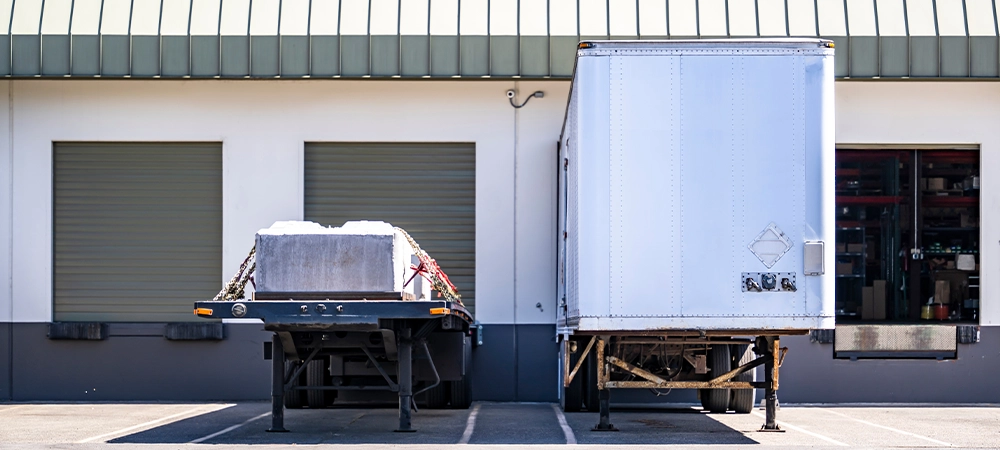
Cargo Flexibility
Dry vans are great for general freight. However, when it comes to size, shape, and load accessibility, flat beds are better.
- Dry Van Can Handle:
- Boxed consumer products
- Furniture and appliances
- Retail shipments
- Pharmaceuticals and cosmetics
- Food and beverage (non-perishable)
- Flatbed Is Ideal For:
- Steel beams and construction materials
- Large machinery and vehicles
- Coiled tubing and rebar
- Modular buildings or sheds
- Industrial equipment with unusual dimensions
Flatbed vs. Dry Van: Security & Safety
Security and safety protocols differ depending on trailer type, especially because one is enclosed and the other is exposed.
| Factor | Dry Van | Flatbed |
| Theft Protection | High (locked doors) | Low (requires external securement) |
| Weather Protection | Full | Requires tarping |
| Risk of Cargo Shift | Low (with pallets) | Higher (requires manual securement) |
| Inspection Frequency | Less frequent | More frequent (load visibly exposed) |
| Load Securement Skill Needed | Basic | Advanced (chains, binders, tarps) |
Flatbed vs. Dry Van: Loading and Unloading Process
Loading efficiency can affect both driver wait times and warehouse productivity.
- Dry Van Loading:
- Rear loading only
- Requires a loading dock
- Uses pallet jacks or forklifts
- Limited to standardized cargo sizes
- Flatbed Loading:
- Loadable from the rear, sides, or top
- Suitable for cranes and forklifts
- Works at non-dock locations (e.g., construction sites)
- Faster for oversized and irregular loads
How to Choose the Right Option for You
Choosing between a dry van and a flatbed trailer isn’t just about the freight but about matching your equipment to your business goals, operational environment, and long-term strategy. Whether you’re a business owner managing outbound logistics or a truck driver deciding on a trailer type, this section will help you weigh your options.
For Business Owners: Which Trailer Fits Your Freight?
Here’s a quick decision guide to help shippers match trailer type to cargo, handling needs, and cost-efficiency:
Business Owner Decision Guide:
- Are your products boxed, palletized or stackable?
Go for a dry van truck - Do your shipments need to be weather or theft-protected?
Go for a dry van freight solution - Do you need to load/unload in areas without a dock or lift?
Go flatbed truck with side/top loading - Are you hauling tall or oversized freight?
Go step deck, double drop or specialty flatbed - Are you shipping food or pharmaceuticals?
Consider refrigerated or heated shipping
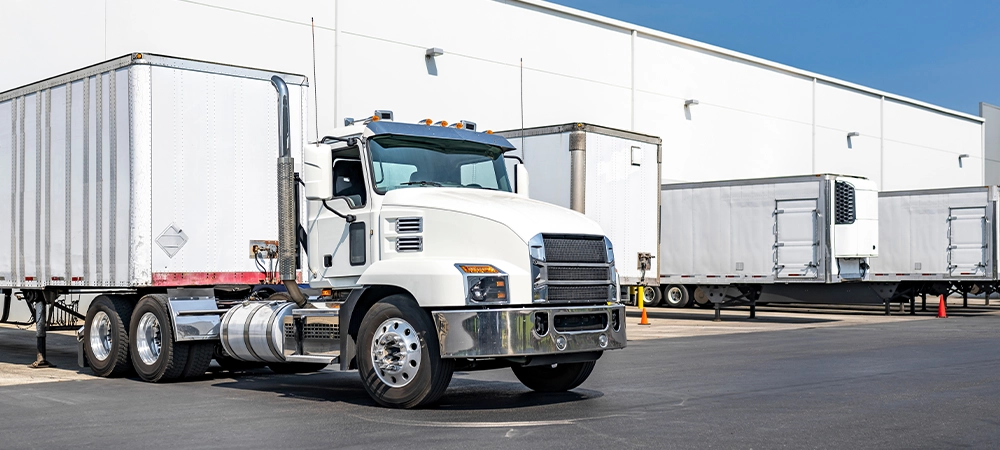
For Drivers: Lifestyle, Earning, and Long-Term Fit
Drivers should choose a trailer type that fits their skills, lifestyle preferences, and income goals. Here’s a side-by-side comparison of what to expect:
| Factor | Dry Van | Flatbed |
| Physical Labour | Low | High (tarping, chaining) |
| Learning Curve | Lower | Higher (load securement knowledge needed) |
| Route Predictability | More consistent | More varied |
| Income Potential | Steady | Higher (esp. with specialty freight) |
| Job Risk | Lower | Slightly higher (exposure to weather, load inspections) |
| Job Flexibility | High | High (with more responsibilities) |
Many experienced drivers eventually transition into flatbed hauling to earn more per mile and take on more challenging loads. Those new to trucking often start with dry vans to build experience.
Best Loads and Opportunities
Whether you have a fleet or drive solo, maximizing trailer usage is key to profitability. Knowing the best types of freight for your trailer and where to find it gives you a competitive edge. Below are the top freight categories and strategies to keep your trailer moving and your revenue flowing.
Dry Van Opportunities:
Dry vans are in demand year-round, especially in consumer-driven markets.
Best Loads:
- Consumer packaged goods
- Retail to warehouses or stores
- Office furniture and fixtures
- Electronics and home appliances
- Food and beverage (dry goods)
Best Load Sources:
- Retail distribution centres
- E-commerce fulfillment warehouses
- National shippers with consistent volume
- Seasonal freight, like back-to-school or holiday retail
Strategy Tip: Build long-term contracts with repeat customers who value delivery consistency and protective handling.
Flatbed Opportunities:
Flatbeds tend to follow market cycles, but the loads pay more, especially for drivers who can manage securement and permits.
Best Loads:
- Construction materials (lumber, rebar, steel beams)
- Heavy equipment (cranes, excavators, generators)
- Large-scale HVAC systems
- Pre-fab structures or containers
- Renewable energy components (wind turbines, solar racks)
Best Load Sources:
- Industrial manufacturers
- Construction project sites
- Energy and utility companies
- Government infrastructure projects
Strategy Tip: Stay informed about regional construction booms and infrastructure grants — these can increase flatbed load rates big time.
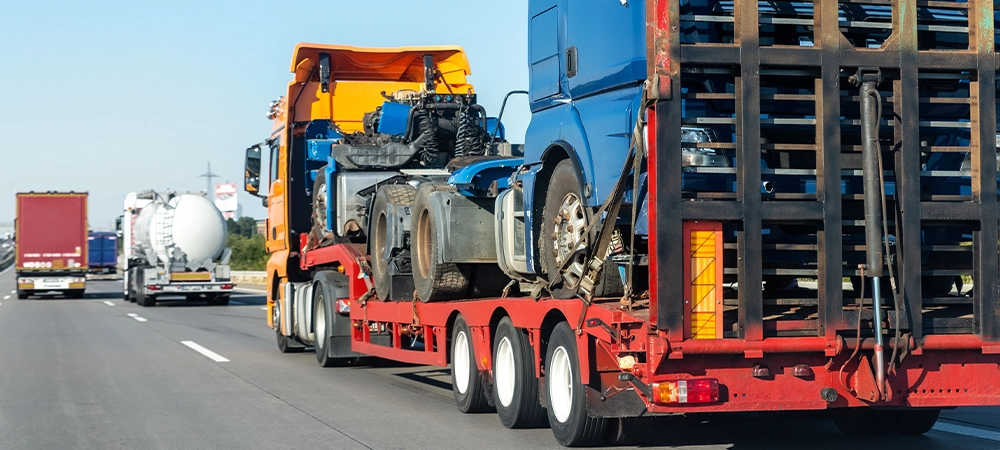
Recommended Platforms and Tactics for All Trailers:
- Use top-rated load boards like Truckstop, DAT, or 123Loadboard
- Join niche broker networks that specialize in your trailer type
- Subscribe to rate trend newsletters to track average flatbed rates or dry van fluctuations
- Set alerts for flatbed shipping quote requests in your target lanes
- Reach out to transport companies in Canada for cross-border partnerships
Flatbed or Dry Van: Make the Right Move
Both flatbeds and dry vans are important in the freight world. Your choice comes down to what you’re hauling, where it’s going and how much flexibility or protection it needs.
At Roadlinx, we help businesses and drivers get the most out of every mile. Whether you need a one-time flatbed shipping quote, recurring dry van freight lanes or flexible LTL freight services, we are here to help.
Need to move food products across the border? We also offer refrigerated shipping and heated transportation to keep your temperature-sensitive cargo safe.
Let’s Talk Logistics That Work
- Get a quote
- Ask about trailer compatibility
- Get help with route planning and compliance
- Start building a logistics partnership with people who get it
Contact Roadlinx today. We move freight with purpose, precision, and care.

